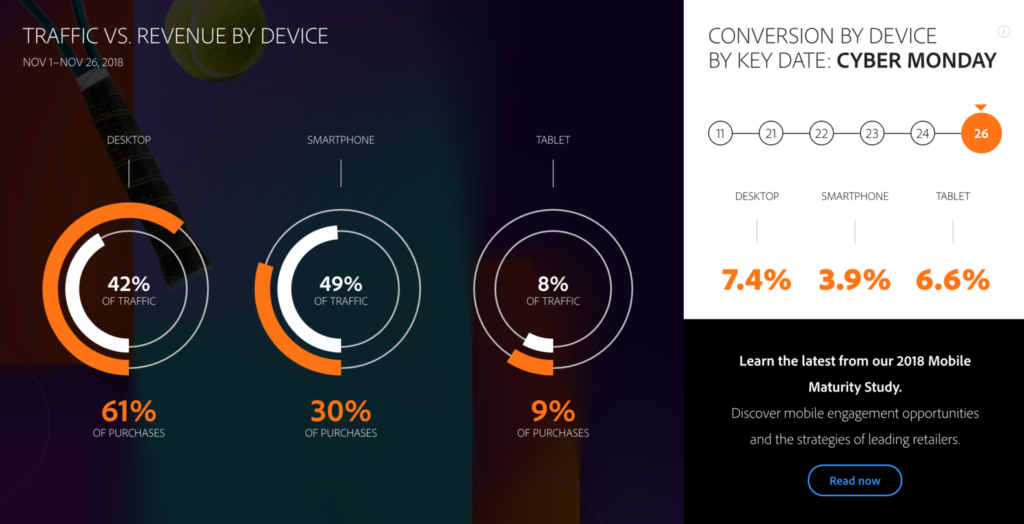
by Don Pingaro | Nov 28, 2018 | Commerce Strategy
At this very moment, retail executives around the US are likely screaming about their Black Friday and Cyber Monday sales performance. For some, these sounds resemble a triumphant war chant, for others, these are the shrill cries of defeat. The reason? Mobile-first adoption.
No matter where you stand, this data changes the eCommerce landscape. Here are the latest stats and key trends from the long-weekend of holiday sales events. We will update this article as soon as new data is released, so make sure you subscribe to be the first to know!
Thanksgiving Takes an Extra Helping
On Thanksgiving day, as of 7:00am Pacific Time, U.S. consumers spent $406 million. By 2pm, Adobe announced that this number skyrocketed to a whopping $1.75 billion, representing a 23% increase over sales in the same time period in 2017. By the end of the day, Americans beat out last year’s sales for the day by a shocking 28%, resulting in a shocking 3.7 billion dollar Thanksgiving. Adobe initially projected a $3.1B bottom line for the holiday.
Mobile Wins Big
Here’s a quick breakdown of the major events in bite-size chunks:
Thanksgiving Day
Black Friday
$2.1 billion or 33.5% of sales came from smartphones this Black Friday. Another 10% of sales, or roughly $627 million, came from tablet users. All in all, the day yielded an impressive $6.2 billion, a 23.6% increase over 2018.
Cyber Monday Breaks The Internet
Here’s the big one. Cyber Monday sales shattered all previous records for online sales… in U.S. history.
“Cyber Monday [topped] $7.9 billion by the end of the day, making it the largest online shopping day of all time in the U.S. This represents a 19.7 percent increase year-over-year (YoY) as of 7:00 p.m. ET. In comparison, Thanksgiving Day and Black Friday brought in $3.7 billion (28 percent growth YoY) and $6.2 billion (23.6 percent growth YoY) in revenue, respectively.”
BusinessWireHere’s the share of devices (as of ~1:30pm ET November 27, 2018):
 See more live stats at ExploreAdobe.com
See more live stats at ExploreAdobe.com
7 Days of Spectacular Sales
Additionally, Adobe’s latest report notes that this November has seen 7 days where total sales broke the $2 billion mark (as of Nov. 28, 2018)… Thanks in no small part to the mobile sales spikes.
Omnichannel Adoption Drives Sales
The trend of “buy online, pick-up in-store (BOPIS)” continued, with the trend growing 50% during this past weekend over 2018. According to Adobe, this spells dollar signs for omnichannel merchants: “As the online and offline retail experience continues to blend, retailers with physical stores drove 28 percent higher conversions online.” While this trend helped retailers increase their share of online earnings, in-store sales lagged far behind.
It’s time to join the mobile-first movement. As Adam Morris, Redstage CEO notes, “Cusotmers are no longer expecting an in-store Black Friday and Cyber Monday, but instead, an omnichannel experience.” While many retailers successfully ramped up their omnichannel strategies for this holiday, the data shows this trend is here to stay, and more work is needed.
If you want to reduce mobile checkout friction before the holidays are over, contact us asap! To see the results we’ve achieved with our recently launched Magento Community Initiative, find the latest data here.
Final Thoughts
These extravagant stats spell success for an industry racing to close the mcommerce gap. It’s seems the industry is all-aboard the mobile-first customer experience wave. As Internet Retailing points out, retailers may have finally reached ‘always-on‘ mobile consumers. Now it looks like the key areas for improvement are streamlining mobile checkouts, and optimizing omnichannel experiences.
Update Nov. 28, 2018
Black Friday + Cyber Monday Stats You Need To Know
Here’s a breakdown of YOY holiday sales by device and region based on data collected by our partners at Nosto!
-
- United States
Desktop: 39% (2017) / 34% (2018)
Mobile: 56% (2017) / 61% (2018)
Tablet: 5% (2017) / 3% (2018)
-
- United Kingdom
Desktop: 47% (2017) / 40% (2018)
Mobile: 42% (2017) / 48% (2018)
Tablet: 11% (2017) / 12% (2018)
-
- Northern Europe
Desktop: 39% (2017) / 37% (2018)
Mobile: 51% (2017) / 57% (2018)
Tablet: 10% (2017) 6% (2018)
-
-
- France
Desktop: 69% (2017) / 67% (2018)
Mobile: 19% (2017) / 22% (2018)
Tablet: 12% (2017) / 11% (2018)
- DACH
Desktop: 40% (2017) / 53% (2018)
Mobile: 42% (2017) / 39% (2018)
Tablet: 8% (2017) / 8% (2018)
Update Nov. 29, 2018
PayPal Mobile Payments Get A $2B Holiday Boost
-
- For the first time in PayPal history, mobile payment volume topped $1 billion, and did so on both Black Friday (November 23) and Cyber Monday (November 26). – PAYMNTS
-
- Adobe reports U.S. shopping carts averaged $138.00 during Cyber Monday, a 6% bump over last year.
-
- 49% of Black Friday traffic came from smartphones, driving 30% of online sales.
- “In the [PYMNTS] Checkout Conversion Index report, the 30 merchants with the fastest, most streamlined online checkouts ranked well. Conversely, the 30 merchants with the lowest scores offer a widely inconsistent checkout experience…”
Update Nov. 30, 2018
Cyberweek 2018 Trends Report
Our partners at BigCommerce identified a few additional trends in their Cyberweek 2018 Trends Report. Key findings include:
-
-
- While online stores continue to have the highest AOV for any sales channel, Facebook took second place, accounting for “70% of total GMV” for Fashion and Jewelry brands using the channel. Home and Garden brands selling on Facebook came in at 16% GMV.
- “The Fashion & Jewelry and Toys & Games verticals saw the highest GMV increases over 2017.

by Don Pingaro | Oct 4, 2017 | Commerce Strategy, UX/UI Design
Did You See It Coming?

Earlier this month, IKEA emerged as the sleeper champ of retail’s augmented reality arms race. On the AI front, companies like Emarsys and Edgecase released eCommerce products that use advanced machine learning techniques to automate time-consuming data analysis and predictive forecasting strategies for retailers. With such tools available to manage mass audiences and their data, this is an opportunity for tech-minded shops to get a leg up on the competition. As a result, we can expect to see some large retailers (those who fail to adapt) fall behind in a relatively short amount of time. Survivors of this retail purge will make themselves known in the next year or two as these technologies become cornerstones of eCommerce. Here are some big changes to expect in the new paradigm of online shopping that everyone will be adding to next year’s budget.
“The IKEA Effect”
 Diving into Apple’s ARkit early-on, the home furniture & appliance giant successfully launched an AR app that lets users view how IKEA’s furniture will look in their home by selecting products from an online store. Released with iOS11, the brand was primed for a massive market reaction. Sure, the items still have some issues (they don’t adapt to lighting too well and their textures aren’t quite realistic), but as the first retail brand to jump into AR, the starting gun has been fired, and many companies are racing to capture value through this technology. Redstage CEO Adam Morris sees huge potential for AR in eCommerce, stating, “There’s certain industries that I see really benefiting from AR, especially companies where seeing the item in-person plays a huge factor. I believe jewelry sales could be completely revolutionized with AR, and then on to home goods like furniture.” However, Morris notes that the eCommerce industry typically lags a few years behind the latest tech trends, relying on major user adoption for companies to jump on the bandwagon. “For instance,” he recalls, “we talked about ‘mobile-first’ for years, well before companies would begin implementing it. Most didn’t pull the trigger until they had no choice — when mobile users made up more than thirty percent of their user base. It’s easy to argue that the industry is still doing a horrible job at mobile commerce, even now with roughly two-billion online shoppers using mobile.” Perhaps the companies that have been slow to catch up with mobile will double-down on AR, or risk giving up their market share to the brands that do. So what happens when health and beauty retailers jump onto this train? If Snapchat can already morph your face and add eye-shadow, will brands like Ulta Beauty and Maybelline step up to the challenge? How will consumers react to no-longer trying on makeup in-store, or to saving bundles of cash testing it through your app? Years down the line, this may even change the supply chain, because stores can test products without actually making them, without buying in bulk, and never worry about hemorrhaging money selling-off failed product. Will proactive make an AR filter to show what you’d look like without acne? Will Schick and Gillette face-off for a chance to show you how to carve up that beard? Furthermore, what will become of Snapchat, now that the company announced it will let brands create their own AR features? The possibilities are endless, and the brands that don’t engage AR or continue to view it as a passing trend will feel it in their bottom lines sooner or later. Watch: Snapchat’s Latest AR Project Puts Artwork All Over US Cities
Diving into Apple’s ARkit early-on, the home furniture & appliance giant successfully launched an AR app that lets users view how IKEA’s furniture will look in their home by selecting products from an online store. Released with iOS11, the brand was primed for a massive market reaction. Sure, the items still have some issues (they don’t adapt to lighting too well and their textures aren’t quite realistic), but as the first retail brand to jump into AR, the starting gun has been fired, and many companies are racing to capture value through this technology. Redstage CEO Adam Morris sees huge potential for AR in eCommerce, stating, “There’s certain industries that I see really benefiting from AR, especially companies where seeing the item in-person plays a huge factor. I believe jewelry sales could be completely revolutionized with AR, and then on to home goods like furniture.” However, Morris notes that the eCommerce industry typically lags a few years behind the latest tech trends, relying on major user adoption for companies to jump on the bandwagon. “For instance,” he recalls, “we talked about ‘mobile-first’ for years, well before companies would begin implementing it. Most didn’t pull the trigger until they had no choice — when mobile users made up more than thirty percent of their user base. It’s easy to argue that the industry is still doing a horrible job at mobile commerce, even now with roughly two-billion online shoppers using mobile.” Perhaps the companies that have been slow to catch up with mobile will double-down on AR, or risk giving up their market share to the brands that do. So what happens when health and beauty retailers jump onto this train? If Snapchat can already morph your face and add eye-shadow, will brands like Ulta Beauty and Maybelline step up to the challenge? How will consumers react to no-longer trying on makeup in-store, or to saving bundles of cash testing it through your app? Years down the line, this may even change the supply chain, because stores can test products without actually making them, without buying in bulk, and never worry about hemorrhaging money selling-off failed product. Will proactive make an AR filter to show what you’d look like without acne? Will Schick and Gillette face-off for a chance to show you how to carve up that beard? Furthermore, what will become of Snapchat, now that the company announced it will let brands create their own AR features? The possibilities are endless, and the brands that don’t engage AR or continue to view it as a passing trend will feel it in their bottom lines sooner or later. Watch: Snapchat’s Latest AR Project Puts Artwork All Over US Cities
The Fully Automatic Customer Journey
 Emarsys’ eCommerce platform is taking the world by storm. Using artificial intelligence to automate various customer retention and acquisition strategies, the AI uses machine learning to quickly create the perfect online shopping experience for each customer. Designed by Forrester, the system quickly crunches oceans of data about site visitors to cater to their needs and desires. After uploading two years of historical user data, eCommerce companies can maximize ROI on existing users. For new users, the Emarsys AI takes an average of 8 weeks to optimize the customer journey and activate recurring campaigns to keep engagement high. While there are many AI competitors out there, Emarsys boasts a robust, user-friendly platform that creates a truly personal experience for each shopper. As Morris describes it, “AI is becoming essential to work personalization into eCommerce, and machine learning systems offer huge advantages over rule-based systems. Marketers do not need to spend nearly as much time tweaking and administering a rule-based system when the AI is optimizing it automatically.” He adds, “We had a customer that doubled their newsletter list from 50k subscribers to 100k. However, since they did not employ any personalization strategies for what products were beingpresented, they only received a 15% increase in revenue from that channel.” As eCommerce threatens to surpass in-store sales (Business of Fashion) personalization of branded messages is critical. What are you doing to cater to each customer?
Emarsys’ eCommerce platform is taking the world by storm. Using artificial intelligence to automate various customer retention and acquisition strategies, the AI uses machine learning to quickly create the perfect online shopping experience for each customer. Designed by Forrester, the system quickly crunches oceans of data about site visitors to cater to their needs and desires. After uploading two years of historical user data, eCommerce companies can maximize ROI on existing users. For new users, the Emarsys AI takes an average of 8 weeks to optimize the customer journey and activate recurring campaigns to keep engagement high. While there are many AI competitors out there, Emarsys boasts a robust, user-friendly platform that creates a truly personal experience for each shopper. As Morris describes it, “AI is becoming essential to work personalization into eCommerce, and machine learning systems offer huge advantages over rule-based systems. Marketers do not need to spend nearly as much time tweaking and administering a rule-based system when the AI is optimizing it automatically.” He adds, “We had a customer that doubled their newsletter list from 50k subscribers to 100k. However, since they did not employ any personalization strategies for what products were beingpresented, they only received a 15% increase in revenue from that channel.” As eCommerce threatens to surpass in-store sales (Business of Fashion) personalization of branded messages is critical. What are you doing to cater to each customer?
Fringe Shoppers Beware
We all do it. We’ll aimlessly surf Amazon or another online retailer looking for something cool to buy, even when we don’t know exactly what we want. Edgecase, the company formerly known as Compare Metrics recently released a new product that helps convert shoppers who have a vague idea or even no idea of what they want. In a time where eCommerce and marketing penetrate the lives of every consumer, tools like Edgecase that help convert the shopping addicted masses are becoming hugely important. When integrated with an online store, the software makes selections for users based on what they’re thinking of (i.e. a blue dress in a certain size) rather than a specific brand. Users can also receive lists of recommended items when shopping for a specific event like a wedding or graduation. As we enter that special time of year, consider how a system built to convert fringe shoppers can have massive impact.
Final Thoughts
As the holiday season looms, companies taking advantage of AR and AI pose the biggest threat to your bottom line. As the eCommerce arms race ramps up, winners and losers will be defined by how they spend their 2018 budget. Make sure you’re planning to implement these tactics by next year’s holiday rush, or risk being left out in the cold.
Further Reading
+ Here’s five other ARkit projects that released with iOS11. + View Redtage’s outlook on the future of marketing & customer experiences. + Ten companies using machine learning in cool ways.

 See more live stats at ExploreAdobe.com
See more live stats at ExploreAdobe.com


Recent Comments